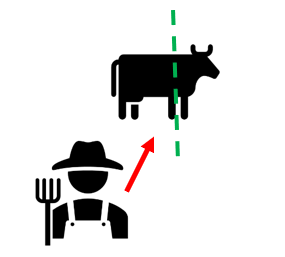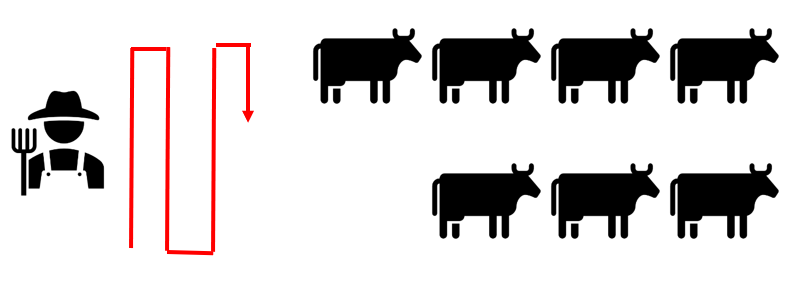Low stress Stockmen Ship is a method for working safely and efficiently with all types of cattle. This method is used with cattle as well as suckler cows and dairy cattle and also works with bulls. Direct contact and loud noises are completely avoided. The animals are moved, stopped or turned by approaching them and, if the response is successful, moving away again.
The handling method founded by Bud Williams, is based on a 2-zone concept and uses the principle of pressure build-up and release. The two zones have no defined size, but are individual to each animal. The outer, larger zone is the observation zone, the zone in which the animal becomes aware of the presence of a person. The inner zone is the movement zone, especially this differs greatly from animal to animal. But regardless of the size of this zone, if the movement zone is entered, the animal will move. If a reaction of the animal was triggered by entering the movement zone, it is part of the principle of Low Stress Stockmanship to step out of the movement zone again - the pressure exerted is thus reduced.

Figure 1: The 2 zones of Low Stress Stockmanship movement zone (blue) and observation zone (yellow). (K. von Deylen, FLI)
Besides the 2 zones, the balance point is also important. This point is the shoulder of the animal and is important for the direction in which the animal will move away. To move an animal forward and away from the handler, approach the animal diagonally, behind the shoulder. This allows the animal to see the person and move away in the desired direction (forward). If the handler stands at shoulder level and moves forward, the animal will move backwards; if the handler moves backwards, the animal will move forward.

Figure 2: Approaching (red line) from diagonal behind the point of balance (shoulder, green line) to move the animal forwards. (K. von Deylen, FLI)
Another important line is the spinal line. It runs centrally from front to back across the animal. If the handler stands in front of or behind the animal (Attention there is a blind spot directly behind the animal) and moves to the right side of this imaginary line, the animal will move to the left and vice versa.
When moving a whole herd, it is advisable to approach the herd in a zigzag movement and again, as a reward for going forward, the person stops or even goes back a few steps.

Figure 3: Approaching a herd in a zigzag course (red line) to drive it forward. (K. von Deylen, FLI)
Originally this handling method comes from the USA, but in the meantime, there are also various seminars on this concept in Germany (as probably in all of Europe). With this method, driving is low-stress for the animals and the risk of accidents for humans remains low. The complete teaching of Low Stress Stockmanship is described in the English book “Stockmanship and Handling Cattle on the Range” by Steve Cote. It is available for consultation on Temple Grandin's homepage.
Impact:
- Socio-economic resilience: It does only cost the will to learn this technique.
- animal health and welfare: Stress free handling is important for good animal welfare furthermore the quite smooth handling will be liked by consumers.
- production efficiency and meat quality: Good handling means to be faster and thus less labour time is needed.
Source of information and audio visual material:
- Bio Austria, Bioland, Bio Suisse, Demeter, FiBL, Naturland, IBLA (2014): Merkblatt erfolgreiches Rinderhandling: wahrnehmen, verstehen, kommunizieren. https://www.bioland.de/fileadmin/user_upload/Erzeuger/Fachinfos/Merkblaetter/Erfolgreiches_Rinderhandling.pdf
- FiBL Film: Stressfreier Umgang mit Rindern - Philipp Wenz zeigt Methode "Low Stress Stockmanship" https://www.youtube.com/watch?v=04esfEMQh1k (German)
- LSSE: Ronald Rongen of LSSE (Low Stress Stockmanship Europe) on a modern dairy farm in the Netherlands https://www.youtube.com/watch?v=6jMUdBdaF9M (Dutch)
- die grüne: Low Stress Stockmanship: Lena & Cäsar Bürgi zeigen den stressfreien Umgang mit Rindern auf der Weide https://www.youtube.com/watch?v=L2YB3DXFOxc (German)
- NCBA's Cattlemen to Cattlemen: Low Stress Cattle Handling (C2C) https://www.youtube.com/watch?v=aW53kbgB-iE (English)
Author: Karin von Deylen, FLI